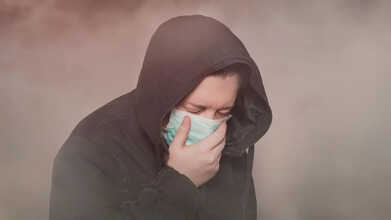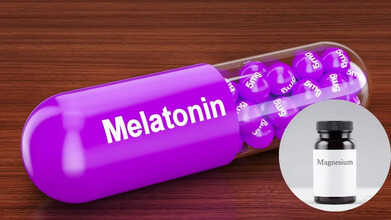- Health Conditions A-Z
- Health & Wellness
- Nutrition
- Fitness
- Health News
- Ayurveda
- Videos
- Medicine A-Z
- Parenting
- Web Stories
Can Antidepressant Make You Feel Suicidal?

Credits: Canva
We know that antidepressants are used to treat mental health illness, especially depression. However, as reported in the Independent, a royal family member Thomas Kingston who was prescribed antidepressants, the same medicines, caused a woman to become severely suicidal.
She is a 48-year-old woman Lingling Wang, who told The Independent that she was not made adequately aware of the potential effects of taking antidepressants before she was prescribed them for insomnia and mild anxiety last January. She said, "My life is finished – I lost my job, almost all my friends, I’m bedridden, I have to rely on my family to feed me.”
She is sharing her story as a coroner issued a warning about the potential effects of medications used to treat depression. Last month, the coroner concluded that Kingston, the husband of Lady Gabriella Kingston, daughter of Prince and Princess Michael of Kent, tragically took his own life due to an adverse reaction to antidepressants.
Experts believe that this is because antidepressants are "overprescribed" in the UK. This has raised serious concerns over the side effects and difficulties a patient faces coming off the medications.
The Independent also found that almost 200 alerts in a decade were made to the UK's medicine regulator over deaths linked to citalopram and sertraline, both of them are antidepressant, which were prescribed to Wang and Kingston.
The Medicines and Healthcare Products Regulatory Agency (MHRA) has announced the review of safety warnings for 30 antidepressants, which includes citalopram, sertraline and mirtazapine.
ALSO READ: Is Elon Musk Struggling With His Mental Health?
A Patient's Struggle with Antidepressant Side Effects
Ms. Wang, from Surrey, shared her experience with antidepressants, which began when her NHS GP prescribed mirtazapine. Despite this treatment, her insomnia persisted, and she developed severe anxiety and low mood. She was then advised to taper off mirtazapine, a process she described as difficult and anxiety-inducing, before transitioning to citalopram.
On citalopram, she reported feeling as if her brain had “completely frozen.” This led to another tapering process and a prescription for sertraline, which worsened her symptoms. Feeling overwhelmed and unsupported, Ms. Wang flew to China to stay with her parents, where she received care from a psychiatrist who helped her discontinue the medication safely. She stated she might not have survived without this intervention.
Need for better patient warnings
Ms Wang has also joined her voice with Lady Gabriella Kingston, to advocate for better patient warnings about the side effects of antidepressants. She also emphasized the importance of patients being fully informed about the risks associated with these medications.
What are the side effects?
The common side effects include: nausea vomiting, indigestion, diarrhea, constipation, low sexual drive, dry mouth, blurred vision, and could increase risk of bleeding by affecting platelet clotting. It also can interfere with blood sodium levels, which can cause headaches, confusion, nausea, vomiting, and drowsiness. Unable to moderate these symptoms, one can feel worse by antidepressants. This is why advocacy and awareness around it is important.
No Relief For Delhi Residents As AQI Levels Spike — What’s Causing The Drop In Air Quality?

Credits: CANVA
Delhi Air Quality Index (AQI) Level Today, 03 November 2025: Delhi’s air quality took a sharp downturn on Monday, slipping deep into the “very poor” category as pollution levels surged across the capital. At 9 a.m., the Air Quality Index (AQI) reached 316, according to data from the Air Quality Early Warning System (EWS).
Forecasts suggest that the air quality will stay “very poor” on November 3 and 5, and could worsen to “severe” on November 4. Experts expect this trend to continue throughout the week. With Diwali week behind us, the question now is, what is driving this sudden decline in Delhi’s air quality?
Delhi Air Quality Worsens
The air in Delhi and the wider NCR has been deteriorating steadily since Diwali ended. On Monday, November 3, the national capital recorded an overall AQI of 324 at 6:05 a.m., according to the Central Pollution Control Board’s (CPCB) Sameer app, keeping it in the “very poor” range. The Air Quality Early Warning System predicts this pattern will continue for several more days, with the AQI possibly dipping into the “severe” category on November 4. Despite the festivities being over, pollution levels remain high, raising concern over what’s causing the continued decline.
Farm Fires Add to Delhi’s Pollution
The Decision Support System (DSS) for air quality management has not updated its latest data, but its October 30 forecast showed that farm fires were responsible for roughly 9% of Delhi’s PM2.5 pollution, with Haryana’s Jhajjar district contributing the most at about 10.66%. Earlier in the season, Delhi’s PM2.5 contribution from stubble burning had stayed below 1%, but in early November, it climbed to around 2%. This rise shows the usual seasonal spike in farm fires, which typically peaks in early November.
Other Factors Behind Delhi’s Falling Air Quality
Delhi’s poor air is not caused by one source alone. Vehicle emissions, construction and demolition dust, and industrial discharge all play major roles in making the air toxic. Seasonal triggers such as stubble burning in Punjab and Haryana and leftover Diwali fireworks make the situation worse. Winds blowing from the northwest carry smoke from these fires directly into Delhi. According to EWS data, wind speeds dropped below 5 kmph on the night of November 2, allowing pollutants to stay close to the ground rather than dispersing.
Why Delhi Suffers More During Pollution Season
Delhi’s geography makes it especially prone to pollution build-up. The city sits in a low-lying plain surrounded by hills and plateaus, forming a basin that traps smog and fine particles. As winter sets in, the cooler air and frequent temperature inversions make the problem worse, preventing pollutants from rising and dispersing into the upper layers of the atmosphere.
Starting November 1, the Delhi government began enforcing the Commission for Air Quality Management (CAQM) directive across the NCR and nearby regions.
The rule bans entry of commercial vehicles that are either not registered in Delhi or fail to meet BS-IV emission norms. Only vehicles powered by CNG, LNG, electricity, or those compliant with BS-VI standards are allowed into the city.
According to official data, October ended on a worrying note for Delhi. The city’s average AQI for the month stood at 223, ranking it in the “poor” category and marking it as the second-worst October for air quality in the past five years.
Can TikTok’s ‘Potato Bed’ Hack Really Help You Sleep Better? Experts Are Not So Sure

Credits: CANVA
Whether you have been bed rotting, taking a lazy nap on a cold Sunday, or simply trying to sleep better this fall, you might be tempted to try the viral “potato bed.” The cozy sleep setup is trending on TikTok, where users are layering their blankets and pillows into potato-shaped nests and inspiring thousands of others to do the same.
Insomnia affects roughly one in three people in the UK, leaving many unable to fall or stay asleep, and this viral “potato bed” trend is being hailed online as a possible fix. In a clip shared on October 29, TikTok creator @alicekateea demonstrated how she built her own potato bed, later claiming, “I had the best night’s sleep ever, omg.”
Her video shows her arranging a fitted sheet with blankets and pillows before curling up inside. Since then, the trend has sparked debate across social media, with many questioning whether the hack actually works, and what sleep experts think about it. Below, we look at why this trend went viral and whether it truly delivers better rest.
What Is the Viral ‘Potato Bed’ Hack?
It is easy to see why the potato bed has caught on so quickly. The setup takes only a few minutes and uses things you likely already own, a fitted sheet, a few pillows, and some blankets, yet the result looks instantly inviting. To create your own, start by clearing your bed and flipping a fitted sheet upside down so the elastic faces up. The elastic edge is what helps form the signature potato shape.
Next, line the inside edges with pillows or folded blankets to form soft, rounded sides. Rearrange and fluff them until you have a snug, oval-shaped nest. For extra comfort, spread one blanket along the bottom, then pull another one over yourself. Once you’ve built your potato, imagine you’re a melting pat of butter — climb in, sink down, and let yourself relax completely.
Is the Viral ‘Potato Bed’ Hack Useful for Sleeping?
The “potato bed” creates a soft, cocoon-like sleeping space that resembles a baked potato. It looks warm and comforting, but does it actually improve sleep quality? Hannah Shore, Head of Sleep Science at Mattress Online, offered her insight into the trend’s possible pros and cons. She explained that if you enjoy being wrapped up and surrounded by warmth, you may find it easier to drift off inside a potato bed. The snug pressure from the cushions mimics the feeling of being held, similar to the soothing effect of a weighted blanket. “That gentle pressure triggers the release of feel-good hormones, helping you feel calm, content, and ready for sleep,” she said.
Still, experts note that the potato bed won’t suit everyone. Not everyone enjoys sleeping in a tightly wrapped or enclosed space, and for some, it may even make falling asleep harder.
Our Body Temperature Needs to Drop a Couple of Degrees to Get Good Quality Sleep
According to Hannah, the main concern lies in temperature control. “Adding more pillows and blankets can reduce airflow, trapping warm air around the body,” she explained. “During sleep, our core body temperature needs to drop slightly for us to reach the deep, restorative stages of sleep.” She also pointed out that support can become an issue. “Mattresses and pillows are designed to support your body in specific ways. By stacking too many cushions or blankets, you could reduce that support, which might leave you sore or stiff in the morning.”
Her verdict? “The potato bed is similar to a nest bed — it has raised sides and plenty of blankets that create a snug feeling. It’s perfect for lounging or a short nap, but not ideal for an entire night’s sleep.”
Nobody sleeps perfectly every night, and that’s normal. It’s still important to pay attention to how we rest, since good sleep affects everything from mood to physical health.
While sleep experts remain divided on whether the potato bed actually helps, they all agree on one thing: real rest depends on consistent sleep hygiene. That means building a wind-down routine, keeping a regular sleep schedule, and maintaining healthy daily habits like exercising, eating well, and managing stress.
Melatonin or Magnesium: Which One Actually Helps You Sleep Faster?

Credits: CANVA
Getting good-quality sleep does more than just help you wake up refreshed—it could also extend your lifespan. A 2023 study found that people who consistently fell asleep easily, stayed asleep through the night, and woke up feeling rested had a significantly lower risk of early death, and were 30% less likely to die from any cause, 21% less likely to have heart disease, 19% lower risk of cancer, and 40% lower risk from other causes.
Given these benefits, it’s no wonder many turn to supplements to improve their sleep. Two of the most popular options are melatonin and magnesium. But which one truly helps you drift into deep, peaceful sleep?
Role of Melatonin In Sleep
Melatonin is a hormone naturally produced by the body that helps signal it’s time to sleep,” says Kenneth Lee, M.D., medical director of the Sleep Disorders Center at UChicago Medicine. According to the Mayo Clinic, melatonin levels rise in the evening when it gets dark and drop in the morning with daylight. “It regulates your circadian rhythm, telling your body when to rest,” adds dietitian Stephanie Crabtree, M.S., R.D.
Melatonin production stays steady through young adulthood but begins to decline after age 40, according to the Cleveland Clinic. That’s one reason melatonin supplements are often studied for older adults. Dr. Lee notes that it can be especially helpful for issues like jet lag, shift work, or misaligned sleep schedules. “If you’re someone who can’t fall asleep until 1 a.m. but need to wake up early, melatonin taken at the right time can help shift your body clock,” he explains.
A 2022 review in Neuroscience & Biobehavioral Reviews found that melatonin helped people with sleep and neurodevelopmental disorders fall asleep faster and stay asleep longer. However, research is mixed for those using it as a general sleep aid. A Sleep Medicine Reviews analysis of 24 studies concluded that melatonin may help some people but is not consistently effective for all.
Side Effects of Melatonin
According to the Mayo Clinic, oral melatonin can sometimes cause headaches, dizziness, or nausea. Less common effects may include mild tremors, anxiety, or confusion. It can also interact with medications such as blood thinners, diabetes drugs, and contraceptives, so it’s important to consult your doctor before use.
How Magnesium Supports Better Sleep
Magnesium is a vital mineral involved in hundreds of body processes, including those linked to rest. “It helps calm the nervous system, relax muscles, and regulate neurotransmitters, which together promote sleep,” says Crabtree. It also supports the body’s natural production of melatonin.
Unlike melatonin, magnesium doesn’t directly trigger sleep but may improve relaxation and reduce nighttime restlessness. “It helps regulate GABA, a neurotransmitter that quiets the brain,” says Dr. Lee. A 2024 study in Sleep Medicine: X found that magnesium L-threonate supplementation improved sleep quality, though the results were based on self-reported data. “In my experience, some patients find magnesium helpful, while others notice little change,” Dr. Lee adds.
Side Effects of Magnesium
According to Dr. Lee, magnesium may cause nausea, diarrhea, or stomach cramps, especially at high doses. The NIH also notes that it can interfere with certain medications, including antibiotics, diuretics, and drugs for osteoporosis or acid reflux.
Melatonin vs. magnesium: Which Is Better?
Research remains inconclusive on which supplement works best. “Melatonin may help if your main issue is falling asleep, or if you’re adjusting to jet lag or shift changes,” says Crabtree. “But magnesium can be more effective for restless nights or tension that keeps you from relaxing. It also supports deep, restorative sleep and can be used safely for longer periods.”
Natural Ways To Sleep Better
Before turning to supplements, experts suggest improving your sleep habits. Dr. Lee recommends:- Practicing good sleep hygiene: Use your bed only for sleep and intimacy, avoid screens or heavy meals before bed, and create a calming pre-sleep routine.
- Trying cognitive behavioral therapy for insomnia (CBT-I): This structured approach helps retrain your mind and body for better sleep.
- Getting screened for sleep disorders: Persistent sleep problems may signal conditions like sleep apnea or restless legs syndrome, which require medical care.
Dietary supplements are meant to complement your diet, not replace medical treatment. They are not designed to diagnose, treat, or cure illnesses. Always consult a healthcare professional before starting any supplement, especially if you are pregnant, breastfeeding, or considering giving it to a child.
© 2024 Bennett, Coleman & Company Limited

